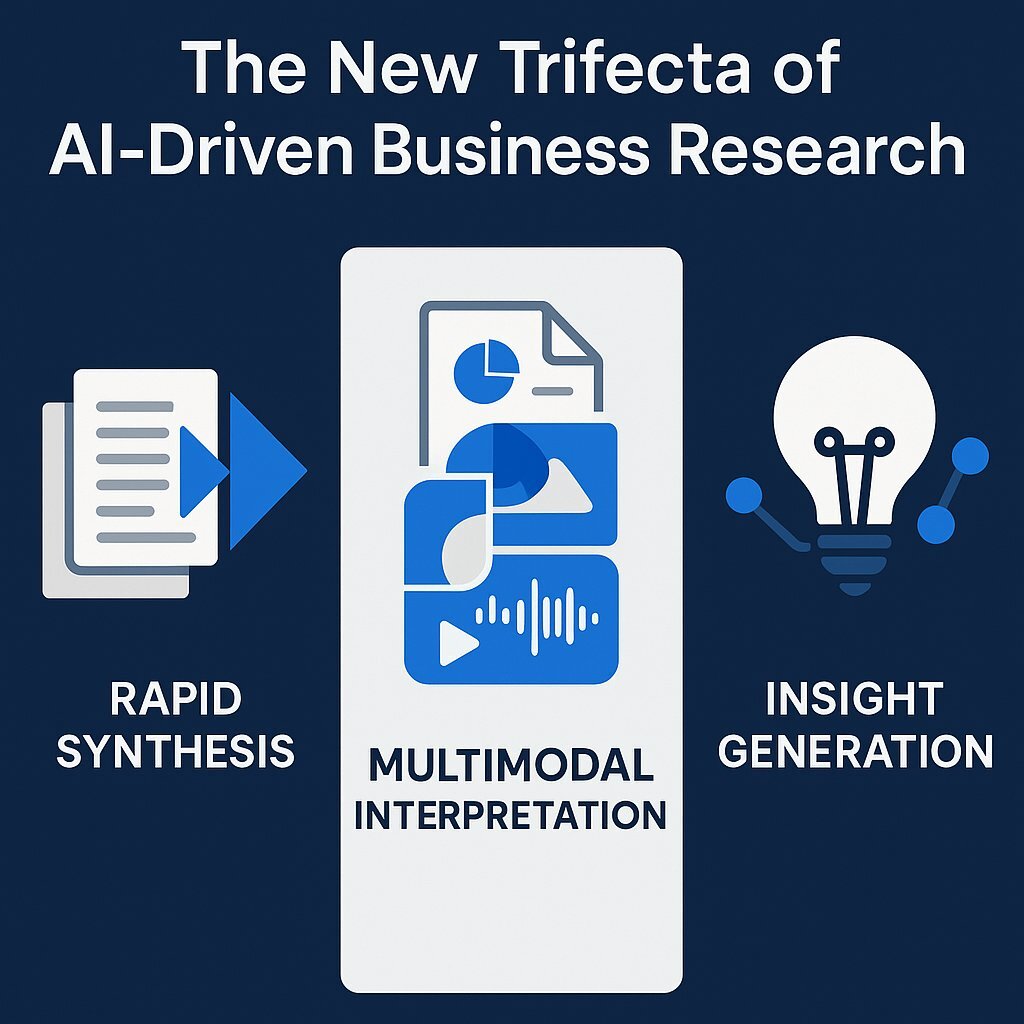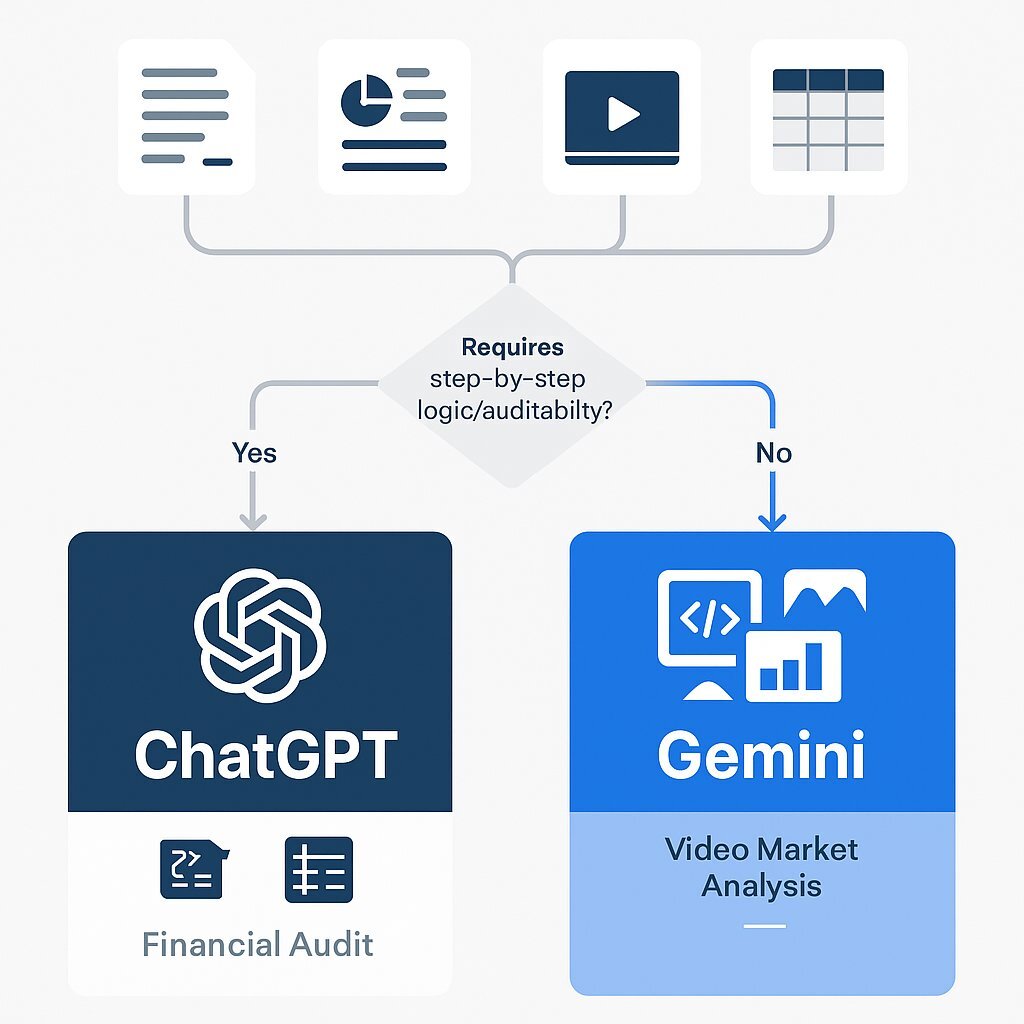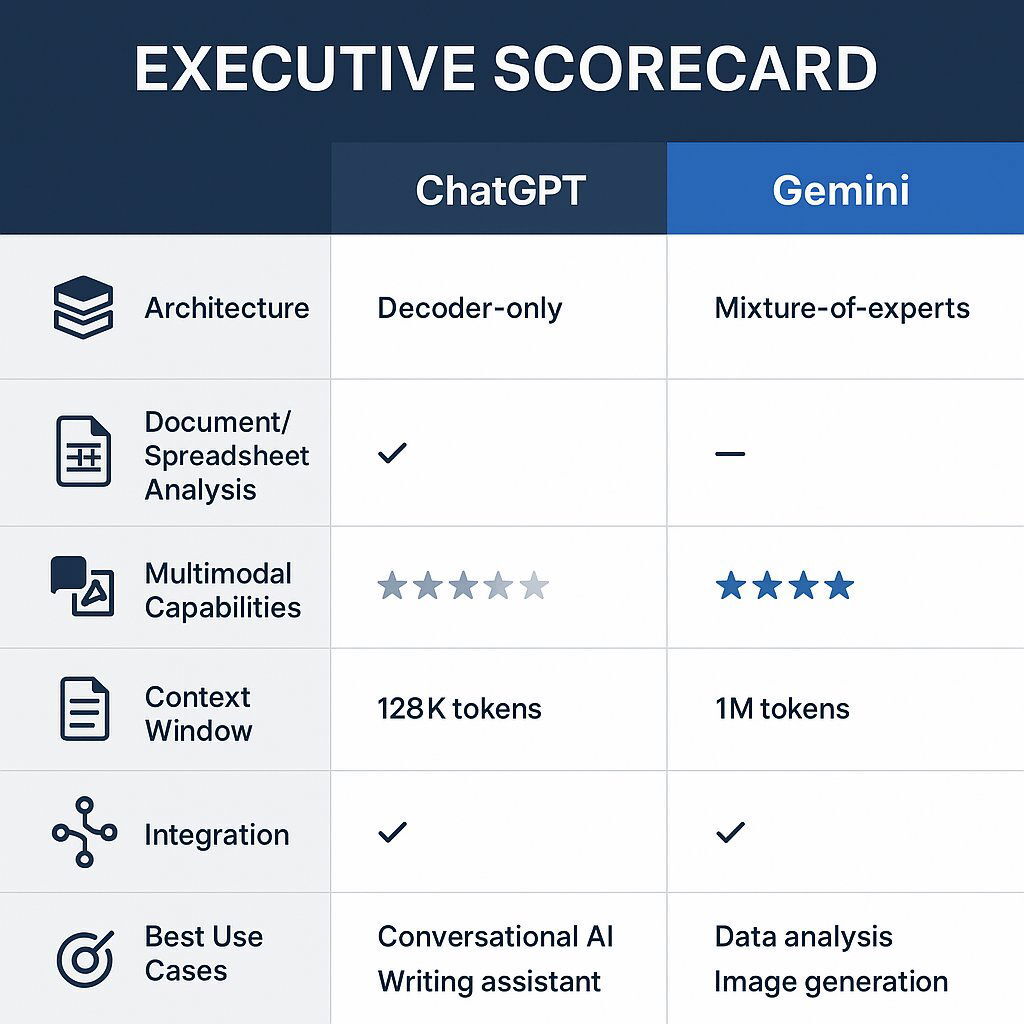
ChatGPT vs. Google Gemini: Ultimate Guide to Deep Research & Business Analysis
July 30, 2025 / Bryan ReynoldsEvery week, a new AI tool promises to revolutionize your business. But as a leader, you're not interested in promises; you're interested in performance. When it comes to the heavy lifting of deep research and analysis—the kind that informs multi-million dollar decisions— which tool actually delivers? We're putting the two undisputed heavyweight champions, OpenAI's ChatGPT and Google's Gemini, in the ring to answer one critical question: Which is the superior tool for in-depth business analysis?
This analysis will tackle the question head-on, addressing the concerns you and your team are asking about accuracy, data handling, integration, and ultimate business value. The evaluation is framed through the lens of a firm that doesn't just use technology but builds it. At Baytech Consulting, we believe the most powerful solutions aren't found off-the-shelf; they're architected for a specific purpose. This article isn't just about choosing a tool, but understanding how to build a strategic capability.

The New Frontier: Redefining "Deep Research" for the C-Suite
The concept of "deep research" has fundamentally changed. The old paradigm involved teams of analysts, multiple disconnected data sources, manual synthesis, and long lead times. Today, a new standard has emerged, enabled by powerful AI tools. It's no longer just about finding information; it's about a new trifecta of capabilities:
- Rapid Synthesis: The ability to ingest and summarize vast amounts of disparate data—from technical reports and financial spreadsheets to customer support transcripts—in minutes, not weeks. These tools can extract key information, compare and contrast documents, and analyze sentiment across a corpus of files.
- Multimodal Interpretation: The capacity to analyze not just text, but the charts within a PDF, the sentiment in a customer call audio file, and the user flow in a product demo video. This moves analysis from a one-dimensional to a multi-sensory process, capturing a richer, more complete picture of the business landscape.
- Insight Generation: The power to move beyond summarization to identify patterns, anomalies, and strategic opportunities that a human analyst might miss. By processing data at a scale and speed previously unimaginable, these models can surface novel connections and insights.
The executive mandate has shifted. The goal is no longer just to be informed, but to achieve a state of continuous, real-time intelligence. This is the demanding benchmark against which ChatGPT and Gemini must be measured.
Architecture as Strategy: How Their Foundations Define Their Function
The technical architecture of these models is not merely a detail for engineers; it is the single most important factor determining their strengths, weaknesses, and strategic fit for your business. A model's "worldview" is shaped by how it was built to "see" data. This fundamental difference in their design philosophies dictates their performance in critical business tasks. Gemini was conceived as "natively multimodal" from its inception, designed to perceive the world as a rich tapestry of mixed media. In contrast, ChatGPT evolved into a multimodal powerhouse by augmenting its masterly command of language and logic with a suite of powerful, specialized tools.
This distinction is not just a feature difference; it's a difference in cognitive style. Gemini may have an intuitive advantage in tasks requiring the seamless blending of modalities, such as understanding a chart in the context of the text surrounding it. ChatGPT, conversely, may excel at tasks that can be deconstructed into discrete, logical, or code-based steps, like performing a rigorous statistical analysis on a CSV file. Matching this cognitive style to your company's primary analytical needs is the first step in making a strategic choice.
ChatGPT's "Augmented Virtuoso" Approach
ChatGPT, powered by models like GPT-4o, can be understood as a brilliant linguistic and logical reasoner that has been equipped with a set of powerful, specialized instruments. It doesn't simply "look" at a spreadsheet; it writes and executes Python code to analyze it within a secure, sandboxed environment known as Advanced Data Analysis (formerly Code Interpreter). This methodical approach is its greatest strength.

The underlying architecture of models like GPT-4 often employs a Mixture-of-Experts (MoE) design. This structure consists of multiple "expert" neural networks, each specialized for different types of tasks or data. When a query is received, the system intelligently routes it to the most relevant experts, making the model incredibly efficient and scalable without incurring prohibitive computational costs for every task.
For business leaders, this architectural choice has a profound implication: it delivers auditable, transparent, and highly rigorous results for quantitative tasks. When ChatGPT analyzes your sales data, it generates code that can, in principle, be inspected. This turns what is often a "black box" into a more transparent "glass box," a critical feature for financial analysis, compliance, or any domain where reproducibility and validation are paramount.
Gemini's "Native Multimodal" Vision
Google's Gemini was engineered from the ground up to understand the world in an inherently multimodal way. It was designed to process interleaved sequences of text, images, audio, and video seamlessly within a single, unified model. It doesn't require a separate tool to "see" a chart in a PDF or understand the action in a video clip; this visual and auditory comprehension is part of its core architecture.
Built upon Google's own Transformer architecture, which it introduced in 2017, Gemini's most significant architectural advantage is its massive context window. While most models handle thousands of tokens (the building blocks of information), Gemini 1.5 Pro can process up to 1 million tokens in its production version and has demonstrated capabilities up to 10 million tokens in research settings.
This is a revolutionary leap for large-scale research. It means the model can analyze an entire codebase, hours of video footage, or a vast library of corporate documents within a single prompt. This enables a completely new class of analysis focused on discovering holistic patterns across huge, unstructured, and mixed-media datasets—a task that was previously impossible to perform at this scale and speed.
The Baytech Insight: Architecting Your Solution
This architectural deep dive directly relates to the "Architect" phase of Baytech Consulting's development process. Just as Baytech's team selects the right technologies, frameworks, and strategies to build a custom application, an executive must choose the AI architecture that aligns with their company's primary analytical "sense." The critical question to ask is: "Is our most vital research more akin to a financial audit, requiring impeccable logic and auditable steps, or is it more like a market ethnography, requiring the holistic synthesis of interviews, videos, and reports?" The answer to that question points directly to the right foundational model for your business.
The Gauntlet: A Head-to-Head Comparison for Core Business Tasks
With an understanding of their core architectures, we can now test these models against the real-world tasks that businesses face every day.
Round 1: Strategic Intelligence & Market Research (Web-Based)
For this task, we simulate a common executive request: "Analyze the key market trends in the renewable energy sector for Q2 2025, citing sources from industry reports and financial news."
- ChatGPT's Performance: In multiple tests, ChatGPT tends to provide more detailed responses with superior sourcing. It frequently includes direct hyperlinks to the specific articles, reports, or data points it references, which makes the crucial step of fact-checking significantly easier and faster for an analyst. Its web search functionality behaves like a diligent research assistant compiling a well-annotated bibliography.
- Gemini's Performance: Gemini's unique strength lies in its process. It often proposes a detailed research plan before executing the search, allowing the user to refine the scope and methodology. This is an excellent feature for clarifying complex requests. However, the final output's sourcing can be less precise, sometimes linking to a general homepage or a broad category page instead of the exact source document, requiring more manual effort to verify claims.
- Verdict: For tasks that demand rigorous, easily verifiable citations from public web sources, ChatGPT currently holds a slight edge due to the higher quality and specificity of its source linking.
Round 2: Internal Document Analysis (PDFs & Spreadsheets)

The "better" tool for analyzing internal documents depends entirely on the type of document being analyzed. This is a critical nuance often missed in surface-level comparisons. ChatGPT's method is to extract text, while Gemini's is to "see" the document. If your team primarily analyzes text-heavy legal contracts or research papers, ChatGPT is highly effective. If they analyze visually rich marketing reports or engineering diagrams, Gemini's native vision provides a distinct advantage.
Sub-Round 2a: The Visually Complex Annual Report (PDF)
- ChatGPT's Approach: It excels at parsing and summarizing the text within a PDF. However, it can struggle to interpret embedded charts, graphs, and complex tables. It might render a table as a jumbled block of text, losing the critical relational structure between rows and columns. While enterprise versions are gaining visual retrieval capabilities for PDFs, this is an added feature, not a native function.
- Gemini's Approach: Here, its native multimodality is a superpower. It can directly "read" the visual elements, answering questions like, "What is the trend shown in the revenue growth chart on page 15 of the attached annual report?" This ability to analyze documents where key insights are presented visually is a massive advantage.
- Verdict: For visually rich, complex documents like annual reports, marketing materials, or technical manuals with diagrams, Gemini is the clear winner.
Sub-Round 2b: The Quarterly Sales Data (Spreadsheet)
- ChatGPT's Approach: This is where the "Augmented Virtuoso" model truly shines. Using its Advanced Data Analysis sandbox, it doesn't just guess; it writes and executes Python code to perform the analysis. It can handle complex calculations, generate statistical summaries, create pivot tables, and produce visualizations like charts and graphs as image outputs. The process is logical, the steps can be reviewed, and the results are highly reliable and free from data-task hallucinations.
- Gemini's Approach: Gemini is also highly capable, utilizing a similar Python-based analysis approach for reliability. Its key advantage is the seamless, deep integration with the Google ecosystem. It can pull data directly from a Google Sheet in your Drive, perform the analysis, and even export the results back into a new Sheet, creating a powerful and streamlined workflow for teams invested in Google Workspace.
- Verdict: This is a tie, with the winner determined by your workflow. For pure, complex data science tasks on a standalone file where transparency and auditability of the code are paramount, ChatGPT's environment is arguably more powerful. For teams living within the Google ecosystem who need to automate reporting and analysis within Google Sheets, Gemini's workflow integration is a game-changer.
Round 3: Multimodal Insight (Beyond Documents)
For this task, we simulate a marketing director's request: "Analyze our latest video marketing campaign. Transcribe the voiceover, identify key visual elements and product placements, and assess the overall sentiment and tone."
- ChatGPT's Performance: It can handle the audio component of the task very well, providing accurate transcriptions and sentiment analysis using its audio processing capabilities. However, its ability to analyze the video content itself is more limited in the public-facing tool. It can analyze individual frames if they are uploaded as images, but it cannot process a continuous video stream to understand action and context over time.
- Gemini's Performance: This is Gemini's native territory. It was built to understand video as a primary data type. You can provide a video file as a direct input and ask complex questions about its content, such as "Generate a list of timestamps where our product logo appears" or "Describe the visual tone of the first 30 seconds." It can do this for hours of video footage thanks to its enormous context window.
- Verdict: For any research that involves video, audio, or a deep synthesis of multiple media types, Gemini has a profound and decisive advantage. It unlocks an entirely new domain of analysis.
The Executive Scorecard: ChatGPT vs. Gemini at a Glance
This table distills the detailed analysis into a one-page summary designed for quick executive consumption. It moves beyond simple feature listings to provide a strategic "so what?" for each capability, helping you make a smarter decision.
| Capability | ChatGPT (Powered by GPT-4o & Specialized Tools) | Google Gemini (Powered by 1.5 Pro & Native Multimodality) | Executive Takeaway |
|---|---|---|---|
| Core Architecture | Tool-Augmented Virtuoso: A master of logic and language that uses specialized tools (like a Python coder) for specific tasks. | Natively Multimodal: Built from the ground up to "see" and process text, images, audio, and video as a unified whole. | Rigorous, Auditable Tasks? ChatGPT. Its step-by-step, code-based approach is more transparent for quantitative analysis. |
| Web-Based Research | Excellent detail and highly specific, verifiable source links. The gold standard for fact-checking. | Generates a clear research plan upfront. Sourcing can be broader and require more manual verification. | Creating a Citable Market Report? ChatGPT. Its sourcing quality is currently more reliable for external research. |
| PDF Document Analysis | Best-in-class for extracting and summarizing text-heavy documents (contracts, manuscripts). Struggles with complex visual layouts. | Superior for visually complex documents. Can "read" and interpret embedded charts, graphs, and diagrams that other systems miss. | Analyzing Your Visually Rich Annual Report? Gemini. It understands the whole document, not just the text. |
| Spreadsheet Analysis | Unmatched Power & Transparency. Uses a sandboxed Python environment to perform complex data science tasks, generating code and visualizations. | Unmatched Integration. Highly capable analysis with seamless connection to Google Sheets and Drive, enabling powerful workflows. | A Forensic Financial Audit? ChatGPT. Automating Your Team's Google Sheets Reporting? Gemini. |
| Multimodal Analysis (Video/Audio) | Strong audio transcription and analysis. Video analysis is limited to individual frames. | Definitive Leader. Can analyze hours of video and audio content natively, identifying objects, scenes, and concepts over time. | Gauging Competitor Video Strategy? Gemini, without question. It opens up entirely new analytical possibilities. |
| Large-Scale Analysis (Context Window) | 128,000 tokens. Sufficient for long documents but requires chunking for massive datasets. | Up to 10,000,000 tokens. Can ingest and reason over entire codebases or vast document libraries in a single prompt. | Finding a "Needle in a Haystack" in Your Entire Corporate Wiki? Gemini. Its context window is a superpower. |
| Ecosystem & Integration | Deep integration with Microsoft 365 . Mature, widely-adopted API serves as an industry standard. | Deep integration with Google Workspace & GCP . A natural extension of the Google ecosystem. | Empowering a Microsoft-based Enterprise? ChatGPT. Supercharging a Google-based Enterprise? Gemini. |
From Prompting to Production: Building a True Business Asset
Using the public-facing chatbots is Level 1. The strategic, long-term value for any business comes from embedding this intelligence directly into your core operational workflows via Application Programming Interfaces (APIs). An executive will quickly recognize the inefficiency and security risks of employees copy-pasting sensitive company data into a public web interface. The natural evolution of this thinking leads to the question, "How do we make this power available securely within our own applications?" This is the critical bridge from using a consumer tool to deploying an enterprise capability.
The API Ecosystem Showdown
- OpenAI's API: OpenAI's API is mature, with extensive documentation and a reputation as a de facto industry standard—so much so that other AI companies often design their APIs to be compatible with it. It provides a robust and well-defined set of endpoints for text generation, image analysis, building custom assistants, and fine-tuning models, making it a reliable choice for developers building custom applications.
- Google's Gemini API: The Gemini API is exceptionally powerful, particularly for developers looking to build applications that leverage its unique multimodal and long-context capabilities. Its deep integration with the Google Cloud Platform (GCP) and Vertex AI provides a suite of enterprise-grade features, including enhanced security, data residency controls, and managed scalability, which are critical for large-scale deployments.
- Developer Experience: Both platforms offer excellent Software Development Kits (SDKs) and resources to get developers started quickly. The choice often comes down to an organization's existing cloud expertise and developer familiarity with either the Microsoft Azure ecosystem (which partners closely with OpenAI) or the Google Cloud Platform.
The Baytech Insight: From API to Application with Agile
An API is a box of parts, not a finished vehicle. A development partner like Baytech Consulting uses its "Build" and "Launch" phases to assemble those parts into a custom solution that fits your business perfectly. This is especially true for AI projects, which are uniquely suited to the Agile methodologies that Baytech employs.

AI and machine learning development is inherently experimental and iterative, making it a perfect match for an Agile approach.
- Data Exploration as a "Spike": The initial phase of any AI project involves understanding the data you have. In Agile terms, this is a "research spike"—a time-boxed investigation to determine feasibility and direction. You don't know what the data can do until you look.
- Modeling as Sprints: The process of building, training, and refining an AI model fits perfectly into iterative sprints. Each sprint can deliver a slightly more accurate or capable version of the model, allowing for continuous feedback from business stakeholders and adaptation to new findings.
- Collaboration is Essential: Agile frameworks foster the close, continuous collaboration between data scientists, software engineers, and business leaders that is absolutely essential for a successful AI project outcome.
This Agile approach de-risks AI development. Instead of a massive, high-risk "waterfall" project with a single outcome far in the future, you build and demonstrate value incrementally. This ensures the project stays tightly aligned with evolving business goals and delivers a return on investment faster. This philosophy directly reflects Baytech's promise to its clients: "We won't waste time or money. We keep things simple".
Conclusion: The Right Tool for the Job, The Right Partner for the Vision
There is no single "best" tool for all deep research tasks. The intelligent choice depends on a clear-eyed assessment of your organization's specific needs, existing workflows, and strategic goals.
Choose ChatGPT if your priority is... best-in-class text generation, rigorous and auditable quantitative analysis (especially on spreadsheets), and you need to integrate with a diverse set of third-party tools or are primarily a Microsoft-centric organization. It is the "logician's tool," unparalleled in its methodical, transparent approach to data.
Choose Gemini if your priority is... analyzing vast and varied datasets that include video, audio, and code; interpreting visually complex documents where charts and diagrams tell the story; and you are deeply embedded in the Google Workspace and Cloud ecosystem. It is the "holistic synthesist's tool," capable of seeing the bigger picture across multiple media types.
The tool itself, however, is only half of the equation. The real competitive advantage comes not from the tool, but from its strategic implementation. Choosing the right AI is a critical first step. But turning that choice into a secure, scalable, and fully integrated business asset is the mission. A partner like Baytech Consulting helps you bridge that gap, moving your organization from simply using AI to wielding it as a true competitive advantage. We don't just deliver software; we own your outcome and build your vision.
About Baytech
At Baytech Consulting, we specialize in guiding businesses through this process, helping you build scalable, efficient, and high-performing software that evolves with your needs. Our MVP first approach helps our clients minimize upfront costs and maximize ROI. Ready to take the next step in your software development journey? Contact us today to learn how we can help you achieve your goals with a phased development approach.
About the Author

Bryan Reynolds is an accomplished technology executive with more than 25 years of experience leading innovation in the software industry. As the CEO and founder of Baytech Consulting, he has built a reputation for delivering custom software solutions that help businesses streamline operations, enhance customer experiences, and drive growth.
Bryan’s expertise spans custom software development, cloud infrastructure, artificial intelligence, and strategic business consulting, making him a trusted advisor and thought leader across a wide range of industries.


